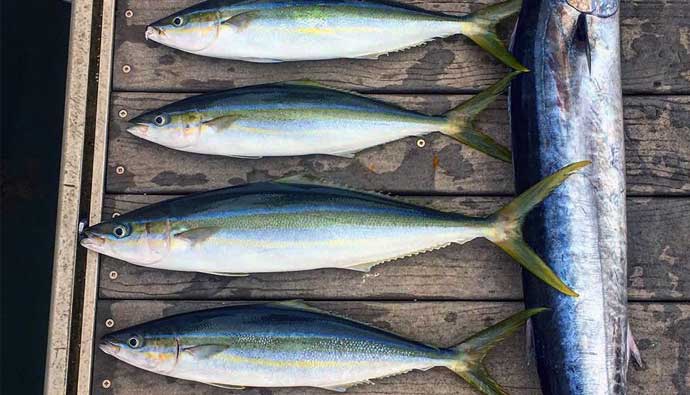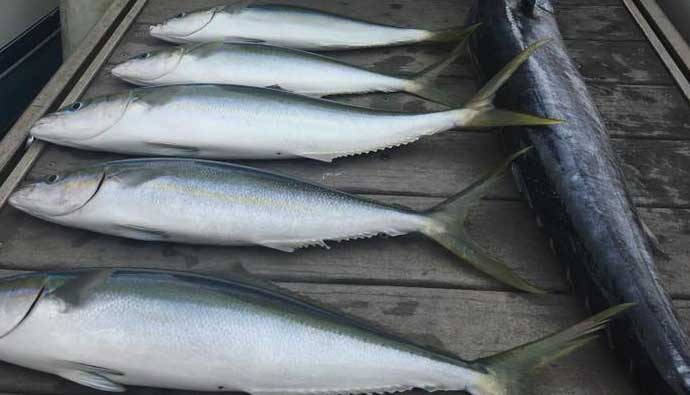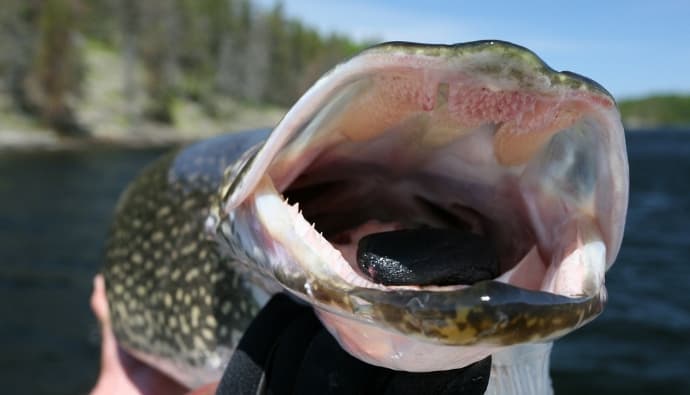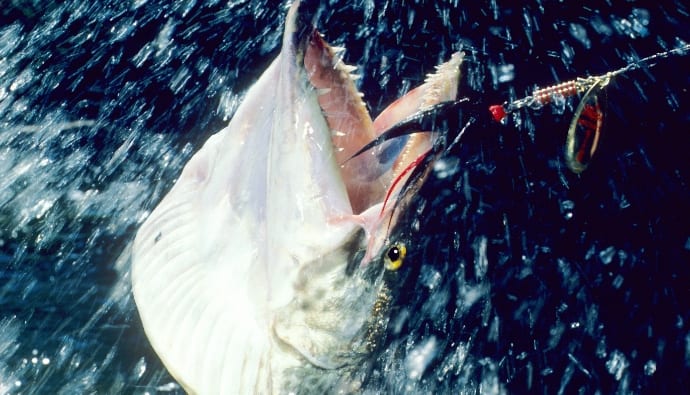Rainbow runner is a fun fish to catch on light tackle.
If you have the chance to see them being chased by larger fish, they tend to leap out of the water to escape their hungry mouths.

They generally travel in small schools, and young ones can often be found trailing sharks.
Get your light tackle gear ready, and let’s go catch a few!
Recommended Rainbow Runner Fishing Gear:
- Rod: Penn Carnage II Medium
- Reel: Penn Spinfisher IV 5500
Overview
Also known as rainbow yellowtail, Hawaiian salmon, and Spanish Jack., rainbow runners are members of the Jack family, along with the blue runner fish, bar jack, and crevalle jack. But they are more slender than their larger cousin, the giant trevally.
The fish can be found in tropical and subtropical waters across the globe, but most are located in narrow belts in 70 to 80°F temperatures. The fish is oviparous, producing pelagic eggs and larvae.
You can usually find them in the Gulf of Mexico, the Western Atlantic, Brazil, and The Western Pacific Ocean.
The body of the fish is compressed and elongated, and it has a long, pointed head and snout. The eyes are small, and the teeth are arranged on jaws on villiform bands. A fun fact about rainbow fish is that it also has small teeth on the roof of the mouth and on their tongue.
They’re called rainbow runners because of their unique, species striking colours.
Rainbow Runner Facts
| Scientific Name | Elagatis bipinnulata |
| Common Name(s) | Rainbow runner, Yellow-tail, Spanish Jack, Skipjack, Runner, Hawaiian salmon |
| Family | Carangidae |
| Identifying Characteristics | Back and topsides have a bright blue color with a stripe. Below that is yellow, bordered with blue again. All the fins are yellow. They have short dorsal and anal fins. |
| Depth Range | 1 to 150 m |
| Habitat | The fish can be found in tropical and subtropical waters across the globe, but most are located in narrow belts in 70 to 80°F temperatures. You can usually find them in the Gulf of Mexico, the Western Atlantic Ocean, Brazil, and The Pacific Ocean. |
| Limits | Check your local regulations |
Rainbow Runner Habitat
Spanish jack fish can be found in shoals in deep water rather than in reefs. While some do venture near reefs at times, most stick to deep drop-offs and open water. As a curious fish, it will often swim right up to scuba divers and swim off at high speed if spooked.
Several of these are caught in large quantities by fishermen who are angling for other fish. The smaller ones can be found in schools, but the larger ones usually swim solo making them difficult to find.
It’s common to find them in the Gulf of Mexico around July and August.
How to Catch a Rainbow Runner

Rainbow runner fishing can be fun if you bring the right gear. The preferable tackle is a medium-heavy spinning outfit with a 30lb braid line, but you can also use a heavier tackle in case you want to catch a large one. Plus, you don’t have to use a wire since the fish doesn’t have sharp teeth that can bite through it.
Since the fish is not picky, you can use a range of techniques to catch it, such as live jigs, bait, trolling, and poppers. It eagerly takes live bait, such as squid and small fish, which you can catch in the area beforehand.
Commonly this fish is used as bait for billfish and tuna.
Rainbow Runner Fishing Tactics
- Use heavy gear to target large Spanish jack fish to tire them out early, or you will have a long fight on your hands.
- This fish is often found close to sharks, so if you catch one, be prepared to reel it in quickly, or you will lose it to the predatory fish.
- A lot of times they will be caught while you’re trolling lures for other fish.
- Good baits include: live and cut fish, squid, octopus, and other crustaceans.
Rainbow Runner Fishing Tips
- Use any lures that you normally use for mackerel, tuna, and wahoo to target Spanish jack fish.
- If you want to catch large rainbow runners, head to Mexico. Head out early morning or late afternoon when the fish is swimming in the open.

Rainbow Runner Fish Seasons
Rainbow runner fishing can be done year-round, but the best months are those when the water is about 79 degrees. This temperature is ideal for spawning for this fish, and it will gather in large shoals to take advantage of this.
How to Clean Rainbow Runners
- Place the rainbow runner on a clean cutting board with its back away from you.
- Use a sharp filleting knife to make an incision behind the gills and run the blade right down the backbone to the base of the tail.
- Flip the fillet over and remove the skin with the knife, ensuring that you don’t cut off the flesh.
- Turn the fish over with the back of the fish towards you before cutting behind the gill plate again and cutting along the backbone right to the base of the tail.
- Flip the fillet over and remove the skin the same way.
Rainbow Runner Fish Recipe
- Clean and scale the rainbow runner, and cut off the fins and the tail. Slice both sides of the fish down the lateral lines to allow the seasoning to penetrate.
- Rub the fish with olive oil and sprinkle some Santa Maria seasoning and paprika all over it inside and out.
- Stuff the stomach cavity with diced cherry tomatoes, minced garlic, onions, and some butter.
- Rub the entire fish in mayonnaise and sprinkle some diced onions on top.
- Wrap the fish in tin foil and place it on the barbecue grill on direct heat for 30 minutes.
- Then open up the tin foil and allow the smoke to get into the flesh of the fish by grilling for another 20 minutes.
- Remove from the grill and allow the fish to rest for 10 minutes before serving.
Rainbow Runner Fish Taste
While this fish puts up a good fight, rainbow runners are known to taste delicious. Some foodies consider its taste close to salmon fish. Tasty.
Frequently Asked Questions
Rainbow runners feed on small fish, cephalopods, and a range of planktonic crustaceans.
The fish can grow to over a meter in length and can weigh as much as 13 lbs.
Yes, they have firm, white flesh, which makes them good table fish.
Insider Advice
Rainbow runners are often confused with the kingfish, but it has brilliant green, purple, and blue colors that the kingfish doesn’t have. This includes two bright blue stripes that run down its side.
If you are rainbow runner fishing in Australia, look for it around New South Wales. Particularly Shark Bay, where it can be found in clean ocean currents deep underwater. Even though the fish has medium commercial value, it is still quite fun to catch, making it an excellent sport fish.




 Facebook
Facebook YouTube
YouTube








